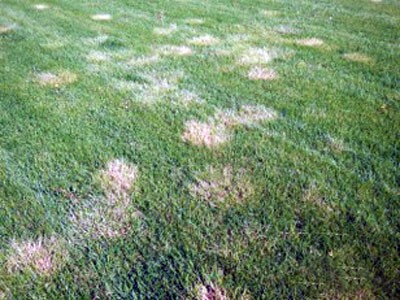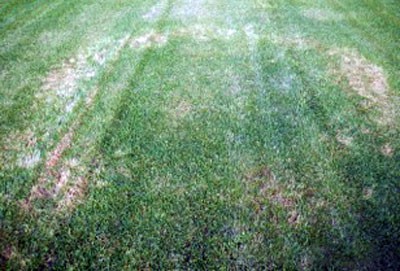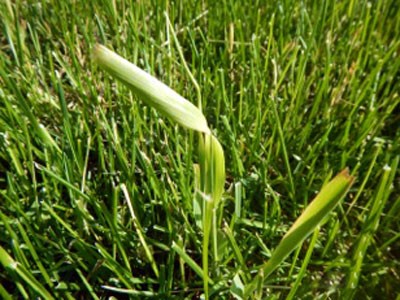Some turfgrass was injured as a result of freezing temperatures last week, but the injury is only temporary.
Kevin Frank, Michigan State University Extension, Department of Plant, Soil and Microbial Sciences – May 15, 2020

Photo 1. Left, freeze injury mimics fertilizer burn or a dull mower blade. Right, freeze injury results in leaf tips “burning back” a couple inches. Photo by Kevin Frank, MSU.
Across many areas of Michigan, nighttime low temperatures dipped into the 20s on several days in the last week. These freezing events have resulted in some interesting freeze injury on turfgrasses.
My experience with this type of freezing event is that the symptoms mimic foliar burn from a fertilizer or pesticide application (Photo 1). The visual symptoms to look for are on the leaf blade, as advised by Michigan State University Extension. If you look closely, you’ll notice the old leaf blades were burned or discolored from the leaf tip down about an inch (Photo 1). Typically, this damage is observed on higher cut turf, i.e., lawn height, and will disappear with new emerging growth and the next mowing.
In addition to the typical burning look on the leaf tips, I’ve also observed some very interesting freeze injury symptoms on different species. Tall fescue clumps contaminating a Kentucky bluegrass turf displayed freeze damage much greater than the bluegrass to the point it looks like someone sprayed them with Round Up (Photo 2).
 Photo 2. Tall fescue clumps suffered freeze injury. Photo by Kevin Frank, MSU.
Photo 2. Tall fescue clumps suffered freeze injury. Photo by Kevin Frank, MSU.
The lush, rapidly growing turf from a type II fairy ring suffered freeze injury that mimics what usually happens later in the summer from drought stress (Photo 3).

Photo 3. Rapidly growing turf in fairy ring was damaged. Photo by Kevin Frank, MSU
One type of freeze injury that brought a smile to my face was viewing the tip of quackgrass leaf blades burned down at least a couple inches from the freezing temperatures (Photo 4). Unfortunately, I doubt this will slow down the quackgrass for very long.

Photo 4. Quackgrass leaf blades suffered only minor injury. Photo by Kevin Frank, MSU
My theory for the damage to the fescue clumps, fairy ring and quackgrass are that any rapidly growing, young leaves were more susceptible to freeze injury than the slower growing or mature leaves. Observing these symptoms also made me think about winterkill and late fall fertilizer applications. One of the risks with late fall fertilizer applications has always been if temperatures warm up following the application and cause a resumption in top growth. When turf is in an actively growing state and experiences a rapid temperature drop, it will not just burn back some leaf blades, but potentially kill the plant


